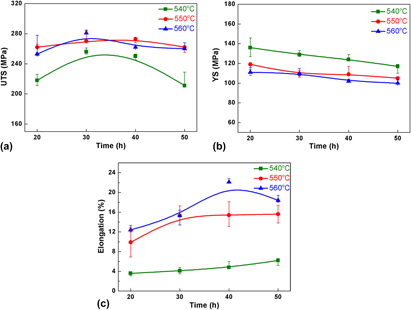Crossref Citations
This article has been cited by the following publications. This list is generated based on data provided by
Crossref.
Chen, Antao
Wu, Guohua
Zhang, Liang
Zhang, Xiaolong
Shi, Chunchang
and
Li, Yanlei
2016.
Microstructural characteristics and mechanical properties of cast Al-3Li-xCu-0.2Zr alloy.
Materials Science and Engineering: A,
Vol. 677,
Issue. ,
p.
29.
Shi, Chunchang
Zhang, Liang
Wu, Guohua
Zhang, Xiaolong
Chen, Antao
and
Tao, Jiashen
2017.
Effects of Sc addition on the microstructure and mechanical properties of cast Al-3Li-1.5Cu-0.15Zr alloy.
Materials Science and Engineering: A,
Vol. 680,
Issue. ,
p.
232.
Fan, Shitong
Deng, Yunlai
Zhang, Yong
Huang, Xinyue
and
Zhang, Xinming
2018.
Homogenization of 7050 plates by a novel differential temperature rolling.
Materials and Manufacturing Processes,
Vol. 33,
Issue. 16,
p.
1822.
Shi, Chunchang
Wu, Guohua
Zhang, Liang
and
Zhang, Xiaolong
2018.
Al–5.5Mg–1.5Li–0.5Zn–0.07Sc–0.07Zr alloy produced by gravity casting and heat treatment processing.
Materials and Manufacturing Processes,
Vol. 33,
Issue. 8,
p.
891.
Yuan, Ting
Jiang, Jinghua
Wu, Yuna
Yuan, Zhipeng
Ma, Aibin
and
Yuan, Yuchun
2019.
Cooperative Effect of Li Content and Equal-Channel Angular Pressing on Microstructure and Mechanical Properties of Al-Mg-Li Alloy.
Metals,
Vol. 9,
Issue. 8,
p.
840.
Yang, Ruibin
Yang, Junrui
Xie, Kun
Liu, Zhongxia
and
Zhang, Guotao
2019.
Investigation of micro-yield strength and coefficient of thermal expansion of Al–Cu–Mg–Li–Sc–Ag alloys with various contents of Li.
Journal of Materials Research,
Vol. 34,
Issue. 15,
p.
2714.
Zeng, Wen
Qin, Weicai
Gu, Cheng
Sun, Hao
Ma, Yilong
and
Cao, Xianlong
2019.
Microstructure and properties of pure aluminum prepared by spark plasma sintering.
Metallurgical Research & Technology,
Vol. 116,
Issue. 3,
p.
312.
Jandaghi, M.R.
Badini, C.
and
Pavese, M.
2020.
Dissimilar friction stir welding of AA2198 and AA7475: Effect of solution treatment and aging on the microstructure and mechanical strength.
Journal of Manufacturing Processes,
Vol. 57,
Issue. ,
p.
712.
Chen, Xiaoxue
Ma, Xinwu
Xi, Huakun
Zhao, Guoqun
Wang, Yongxiao
and
Xu, Xiao
2020.
Effects of heat treatment on the microstructure and mechanical properties of extruded 2196 Al-Cu-Li alloy.
Materials & Design,
Vol. 192,
Issue. ,
p.
108746.
Zhang, Xuejian
Wang, Hongwei
Yan, Bing
Zou, Chunming
and
Wei, Zunjie
2021.
The effect of grain refinement and precipitation strengthening induced by Sc or Er alloying on the mechanical properties of cast Al-Li-Cu-Mg alloys at elevated temperatures.
Materials Science and Engineering: A,
Vol. 822,
Issue. ,
p.
141641.
Shi, Chunchang
Wu, Guohua
Zhang, Liang
Zhang, Xiaolong
Sun, Jiangwei
Zhang, Jinshuo
and
Wang, Yixiao
2021.
Variation in the microstructure and mechanical properties of permanent mold cast Al–3Li–2Mg–0.1Zr alloy with Zn addition.
Journal of Materials Research,
Vol. 36,
Issue. 10,
p.
2071.
Sun, Zeyu
Tian, Xiangjun
He, Bei
Li, Zhuo
and
Tang, Haibo
2021.
Microstructure evolution and microhardness of the novel Al–Cu–Li-xSc alloys fabricated by laser rapid melting.
Vacuum,
Vol. 189,
Issue. ,
p.
110235.
Yogesha, K. K.
Joshi, Amit
Raja, A.
Jayaganthan, R.
and
Verma, Raviraj
2023.
Effect of Different Rolling Techniques on Fatigue Crack Propagation in 5052 Al Alloy.
Metallography, Microstructure, and Analysis,
Vol. 12,
Issue. 1,
p.
62.
Ma, Ning
Zhu, Jianfeng
Chang, Ke
and
Qin, Yuxing
2024.
Effect of Mg on Plasticity and Microstructure of Al-Mg-Ga-Sn-In Soluble Aluminum Alloy.
Materials,
Vol. 17,
Issue. 21,
p.
5287.
Zhang, Shuo
Qi, Fangzhou
Zhang, Liang
Wu, Guohua
Tong, Xin
Zhan, Junmin
Wang, Yan
and
Geng, Yingjing
2024.
Effect of aging treatment on high temperature mechanical properties of a cast Al–Li–Cu alloy.
Materials Science and Engineering: A,
Vol. 896,
Issue. ,
p.
146300.
